Introduction
Applications using SiC semiconductors began in the 2000s with the adoption of SiC JBS diodes for PFC (Power Factor Correction) applications. Later, SiC diodes and FETs were used in the PV (photovoltaic) industry. Going forward, the recent surge in applications related to EV on-board chargers and DC-DC converters is expected to drive the growth of SiC semiconductors. The early adoption of 650V devices for EV inverters and server power supplies and 5G telecom rectifiers promises a rapid future growth for SiC semiconductors. This article discusses the advantages of rapidly growing SiC semiconductors over current Si technology.
Advantages of SiC semiconductors
The advantages of using SiC FETs over IGBTs are well documented. The wider bandgap of 4H-SiC allows voltage blocking layers to be formed with resistances 100 times lower than in unipolar silicon devices. In addition, SiC semiconductors have three times the thermal conductivity of silicon semiconductors. Although SiC MOSFETs have improved in performance from 650 to 1700 V in both planar and trench structures, SiC-MOSFET channel mobility is still poor.
SiC JFET-based cascode FETs, on the other hand, employ SiC-JFETs for smaller chip sizes due to the high bulk mobility of the SiC JFET channel. In the rest of this article, SiC transistors are referred to as SiC FETs unless the distinction is required. This is because in most cases SiC transistors and SiC FETs can be used interchangeably.
Above 1200V, IGBTs replace MOSFETs and offer lower conduction losses at high load currents, but conductivity modulation results in lower conduction losses but worse switching losses. IGBTs are typically used with anti-parallel fast-recovery PiN diodes. This is because the charge stored in the diode must be removed before it transitions to the off-state voltage. This also affects switching losses.
Figure 1a compares the Qorvo FET on-state characteristics with a standard 200A, 1200V IGBT. For all operating conditions below 200A, especially in the absence of knee voltage, SiC semiconductors can be used to reduce conduction losses.
Figure 1b compares the third-quadrant characteristics of a Si FRD (First Recovery Diode), a Qorvo FET, and a SiC MOSFET without using an anti-parallel Si FRD or without using a SiC semiconductor Schottky diode. If the SiC MOSFET does not have integrated anti-parallel diodes or SiC Schottky diodes, the conduction losses of SiC MOSFETs are much higher than those of FRDs commonly used with IGBTs. Both SiC MOSFETs and Cascode FETs operate with low QRR (often ten times lower than Si FRDs). Therefore, SiC FETs can switch much faster than IGBTs, but synchronous rectification is essential to avoid transient third-quadrant conduction losses.
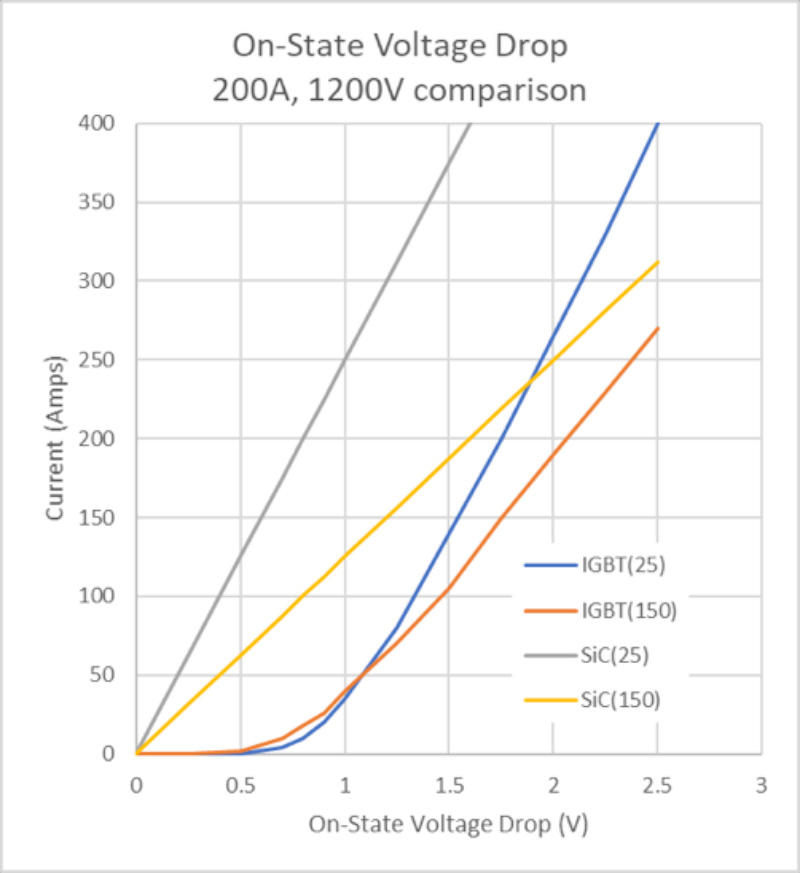
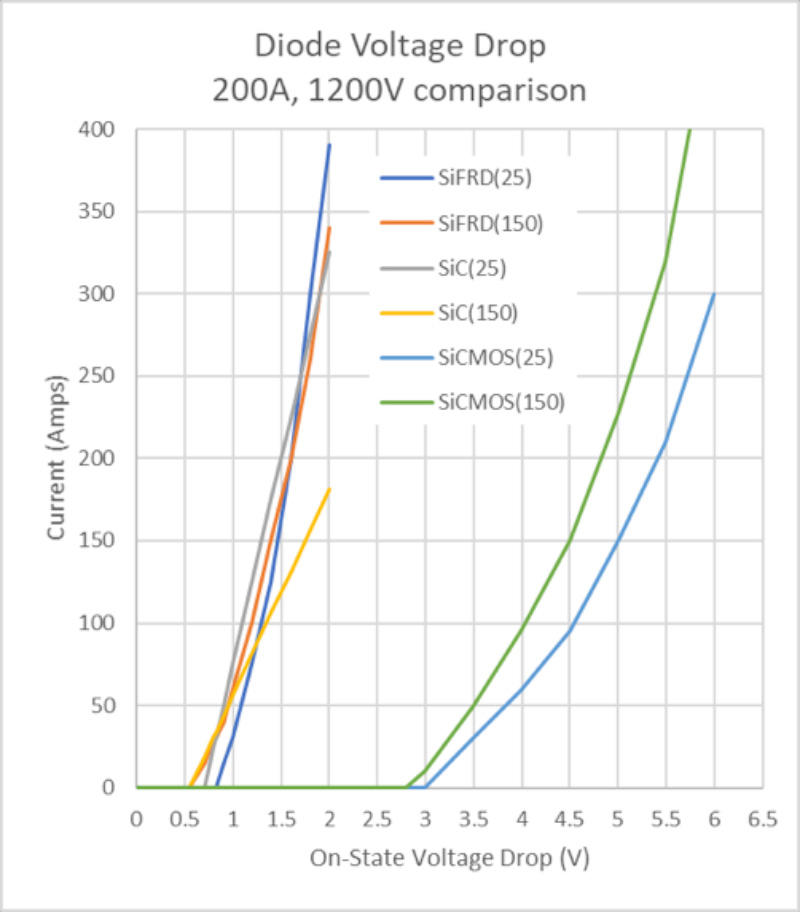
SiC diodes are widely used in PFC circuits and boost converters. This is because EON losses in low-side FETs are greatly reduced because SiC diodes have no stored charge, whether in 650V superjunction MOSFETs at 400V bus voltages or fast IGBTs at 600-1500V bus voltages. is. In fact, the advantage of using SiC JBS diodes increases with voltage. Even without using SiC FETs as the main switching device, these diodes contribute to increased efficiency and higher operating frequencies. The market size for these products is still over 10 billion yen ($100 million).
Advantages of SiC semiconductors in hard-switched circuits
Table 1 shows the datasheet parameters needed when evaluating switch technology for hard switching applications. Let's look at some important points.
For server power, telecom rectifiers and on-board chargers operating at 400V bus voltage, totem-pole PFC topologies, or 3-phase active front-end rectifiers are used depending on the power level. To improve power density and reduce BOM cost, higher switching frequencies are needed to reduce inductor size. High-side FET's EON loss is large, so the superjunction FET cannot be used in continuous conduction mode (CCM).
Due to excessive loss and recovery characteristics, lowering the voltage to reduce the QRR will degrade the lifetime. Qorvo's SiC FET solutions use diodes with excellent low QRR characteristics, resulting in significantly reduced EON losses. Available in Kelvin-source packages such as TO247-4L, D2PAK-7L, and DFN8x8, designers can achieve hard switching frequencies two to three times higher than available in silicon. All Qorvo SiC FET products also offer optional low TCR (Temperature Coefficient of Resistance) characteristics. Products with a low TCR result in less increase in on-resistance with temperature.
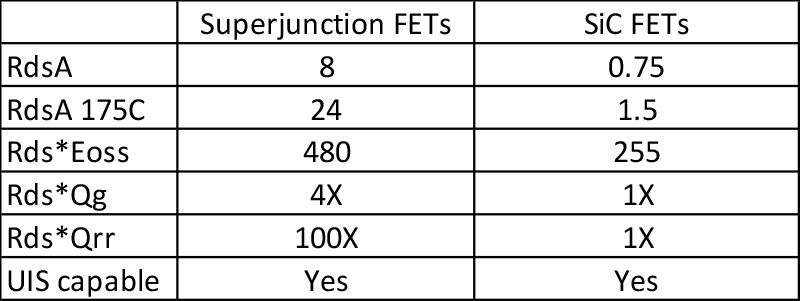
Advantages of SiC Semiconductors in Soft Switch Circuits
Phase-shifted full-bridge and LLC circuits for DC-DC conversion are widely used in server power supplies and telecom rectifiers, and EV on-board chargers and DC-DC converters. The value of wide bandgap switches in general, and SiC-based FETs in particular in these applications, derives from several key properties.
First, the low Coss of SiC FETs allows fast VDS transitions at turn-on, allowing the use of high switching frequencies or wide input/output voltage ranges.
Second, the soft-switching turn-off loss can be estimated as the measured hard-switching turn-off energy minus the energy stored in the output capacitance, denoted as EOFF-EOSS. Also, as shown in Figure 2, SiC FETs such as Qorvo's UF3C120040K4S have very low turn-off energy.
Third, the low RDS(ON) value combined with the high voltage rating allows DC-DC converter operation at 800V.
Fourth, SiC FETs have very high voltage slew rates in the range of 100–200 V/ns and small reverse recovery charge characteristics. This virtually eliminates dv/dt induced impairments without shortening the carrier lifetime.
Finally, UnitedSiC FETs in particular have a body diode drop of typically 1.5V, which is very low compared to 3-5V for SiC MOSFETs and GaN HEMTs. As the frequency increases, the proportion of time that the body diode conducts increases, further increasing diode conduction losses during dead time.
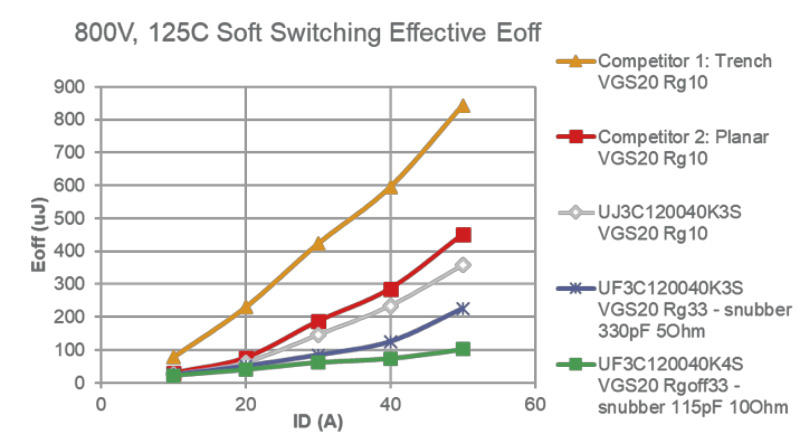
A loss of 100µJ at 50A, 800V means that the device develops turn-off switching losses of 10W at 100kHz when used in a PSFB at that current. At low currents, these low losses allow frequencies up to 500kHz
Advantages of SiC Semiconductors in EV Traction Inverters
The lower losses of Qorvo SiC FETs in hard switching benefits EV traction inverters. Also, when the operating frequency of the motor drive is low, the advantage is low electrical conduction losses.
This is already shown in Figures 1a and 1b. This is due to the low resistance per unit chip area and, unlike IGBTs, the lack of knee voltage in forward conduction, as well as the possibility of reverse conduction due to synchronous rectification. A key characteristic of switches required for EV applications is to withstand various types of short-circuit faults. This means that the switch can withstand the entire bus voltage (400V for 650V devices, 800V for 1200V devices) and at the same time large currents. This large current flows when the gate is fully on, which is 0.5-2µs after the blanking time, until the desaturation detection circuit finds a short circuit condition. must flow.
The driver then tries to switch off quickly. During this time the temperature rise of the switch can be 300-500°C in a few µs, but it should still turn off safely. Additionally, a switch should handle up to 100 or 1000 such events without shifting device parameters. This characteristic is met for IGBTs, but SiC MOSFETs and GaN HEMTs struggle to meet the same level of robustness. Qorvo's cascode FETs have the ability to safely handle repeated short circuits while minimizing chip size or on-resistance trade-offs. This product is a bulk conduction device, due to the inherent properties of normally-on JFETs, which have no gate oxide to degrade and can withstand higher temperature and electric field peaks than SiC MOSFETs.
In addition, the reduction in channel conductance due to self-heating causes the current in the device to drop rapidly, slowing the heating rate and thus prolonging the time before failure of the device. SiC devices are generally more robust in this mode as these vertical devices absorb heat within their volume. GaN HEMTs, on the other hand, are lateral devices that generate heat with an ultra-thin two-dimensional electron gas.
Advantages of SiC Semiconductors in Linear Mode Applications
Figure 3 shows the normalized VTH versus temperature characteristics of normally-on SiCJFET, SiC MOSFET and Si MOSFET. It is clear that only normally-on SiC JFETs avoid VTH degradation with temperature.
If the device is used as a current source, or in a deliberately slow-switching solid-state breaker, even in the low-current, low |VGS-VTH| region, depending on the time spent, The device is susceptible to current filamentation, resulting in a negative VTH temperature coefficient and can fail at voltages much lower than expected. It has been demonstrated that this does not occur in UnitedSiC's SiC JFETs. Qorvo's SiC JFETs are therefore very useful for forming current sources, electronic loads, etc. It can be biased in the low current high voltage loss region without breaking down to the rated breakdown voltage.
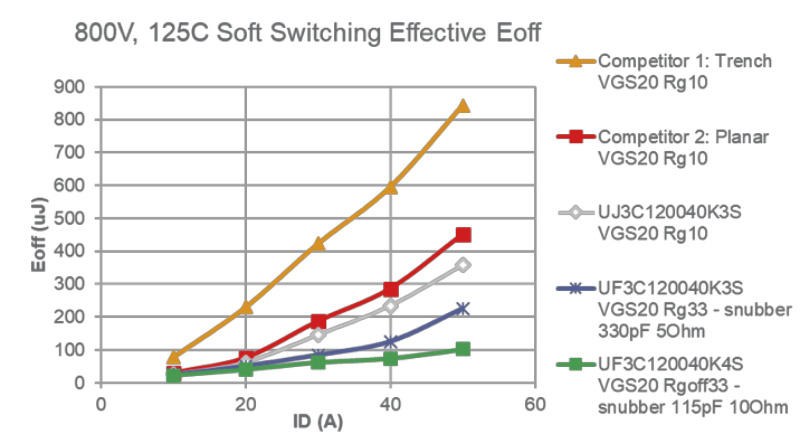
Negative slopes result in unstable operation at high VDS and low |VGS-VTH|. This problem does not exist in normally-on SiCJFETs.
Advantages of SiC semiconductors in circuit protection
The fact that VTH does not degrade with temperature, the excellent current limiting and shorting capabilities of SiC JFETs, and the ability of SiC JFET devices to withstand four times higher energy dissipation than silicon devices to failure, make these devices a circuit breaker, Very useful as an inrush current limiter and load switch. JFETs offer the lowest RDS(ON) for a given chip size and can withstand repeated overstress events, thus reducing conduction losses during operation without compromising device robustness.
A New Approach to Flexible High Voltage FETs
Qorvo has implemented a super-cascode approach to high voltage FETs. This is a very high voltage switch realized by connecting many normally-on JFETs in series using low voltage Si MOSFETs and a unique bias network. This product can be used as a 3-terminal switch in a composite device. A 200A, 6500V half-bridge module under development has five stages of 1700V JFETs connected in series. The device can be switched with a low Qg 0-12V single gate drive.
It is not necessary to prepare the gate drive for each stage, which is required when IGBTs and SiC MOSFETs are connected in series. Another demonstration of low-current switches applied the super-cascode technique to a 40kV single switch. The maturity of low-voltage JFET technology and the low cost of materials allow designers to offer previously unachievable low-cost solutions to high voltages. It can also be easily built using Qorvo's cascode and JFET devices if no device is available for the desired voltage or current class.
This article has attempted to cover many of the basics while briefly explaining the benefits of Qorvo's SiC FET and SiC JFET based solutions for a wide range of applications. For more information on these subjects, please refer to Qorvo's website and publications.
Qorvo's SiC FETs can not only improve the design of high frequency DC-DC and AC-DC applications, but they can also be drop-in replacements for existing silicon-based designs due to their wide gate drive operating range. . The advantages of UnitedSiC's SiC FETs in EV inverters have been described from low conduction losses to robust short-circuit handling. Active mode and circuit protection applications, especially for high voltages and high powers, are areas that only SiC JFET technology can handle, building flexible high voltage high current switches using low voltage JFETs like building blocks. I can. These applications are also described in separate articles that have already been published. Please refer to them as well.
Inquiry
If you have any questions regarding this article, please contact us below.
Qorvo manufacturer information top page
If you want to return to Qorvo manufacturer information top page, please click below.
